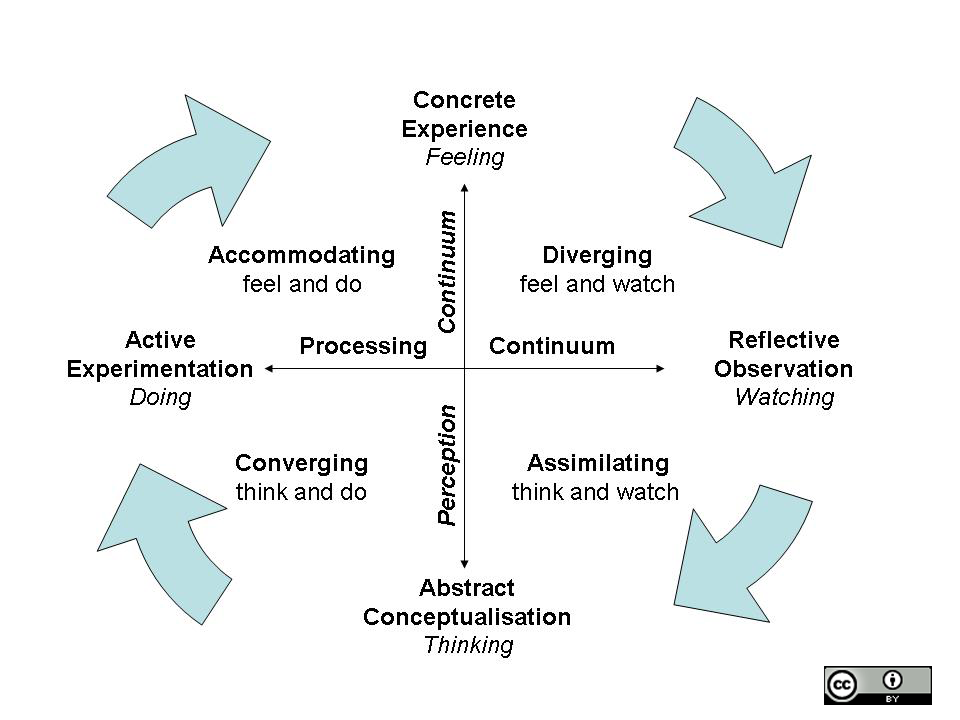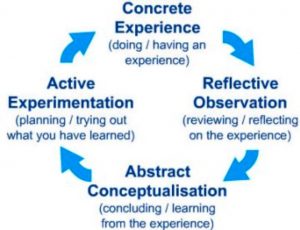3 Kolb’s Learning Model
In this chapter you will be exploring who you are as a learner. That is, you’ll be learning about your own learning style and performing metacognition. This is important for Prior Learning because the better you can understand how you learned the areas of expertise, the better you can explain that expertise to your portfolio reviewers.
It’s worth the effort to practice metacognition–to think about your own thinking–so that your portfolio expresses your learning in a clear way. In fact, you will use the learning cycle outlined below as a framework for describing your learning when you write your Educational Narrative.
Experiential Learning
Some say that all learning is experiential, which means learning by doing or learning from direct experience. Humans have been doing this type of learning from the beginning of time. Think about how you learned to walk, ride a bicycle, or play a sport. You start with small steps, then gradually improve, and eventually you don’t even have to think about what you do.
Sometimes experiential learning is contrasted with academic (or didactic) learning, learning from a book or a lecture. Going to the zoo and learning about animals through observation and interaction is experiential learning; reading about animals in a book is academic learning. There is a place for each kind of learning, but in this course we are focusing on the experiential type.
PLA transforms your experiential learning by allowing you to articulate what you have learned from your experiences.
Kolb’s Learning Model
David Kolb has been a pioneer in the field of experiential learning, visualizing his theory in his Learning Model (1984). His model depicts a cycle. The following is a visualization of his model:

under license”Creative Commons Attribution 4.0 International“
This illustration shows the four learning styles. According to Kolb, a person usually has a preference for at least one learning style but can also develop facility in others with exposure. The four styles, simply put are:
- Diverger: Enjoys seeing things from many viewpoints, is imaginative and enjoys working with people
- Assimilator: Likes the world of ideas and abstract concepts; does not necessarily need to relate them to real-world situations
- Converger: Enjoys working to solve abstract problems using logic and analysis, but enjoys applying solutions to real-world situations.
- Accommodator: Likes solving problems in a hands-on fashion and enjoys taking action
This illustration also displays Kolb’s learning cycle. The cycle symbolizes the journey of a person when learning occurs. According to this theory, to learn a person needs to go beyond the concrete experience through a process of reflection, analysis (conceptualization) and testing (experimentation)—basically a scientific process.
Kolb described learning as “the process whereby knowledge is created through the transformation of experience.” (Kolb, 1984, p.38). Kolb states that learning is a process that requires the learner to move around the wheel.
Starting Anywhere In Kolb’s Cycle
A person can start anywhere on the wheel, depending which is the individual’s preferred learning style. We don’t have to start at the top with Concrete Experience–sometimes we think about something first, or read about it and research first, or play around with knowledge first.
This is key: when you think about your experiential learning, remember which style of learner you are, and perhaps start at that point in Kolb’s Cycle. But also remember that circumstances can affect that learning style, and you may start in different places in the cycle depending on what you’re learning.
Here’s a simplified version of Kolb’s cycle we’ll use to discuss this further:

For the purposes of understanding the different starting places within this cycle, we’ll use a simple example of someone building a birdhouse.
Remember that, according to Kolb’s theory, one concrete experience isn’t enough to cause learning. Someone must have a concrete experience, then go through a process of reflection, analysis (conceptualization) and testing (experimentation), to have learned something.
Here are a few scenarios of how someone might start at different points in Kolb’s cycle:
Starting Point: Active Experimentation. This person, an Accommodator, might decide one day, “You know, birds are kind of awesome. I really want more birds around the house.” So they plan a way to make that happen. They go out to their workshop and hammer some small boards together, without looking too closely at other birdhouses; no instructions, no YouTube videos. They just jump in and try out what they’ve observed.
When they put out the birdhouse, perhaps no birds use it. This is the Concrete Experience component: they’ve made something and are experiencing failure. So, they have to move into Reflective Observation: why aren’t the birds using the birdhouse? After coming up with some ideas, they move into Abstract Conceptualization, where they come up with new and better birdhouse designs, and then they move back into Active Experimentation: building version two of their birdhouse.
Starting Point: Abstract Conceptualization. This learner begins with questions and deep thinking: “Bird houses are fascinating. I wonder what makes for the best birdhouse? How can I build a better one?” So they head out to the workshop, and enter the Active Experimentation phase. They build some prototypes, and when finished, set them up in the yard. This is the Concrete Experience phase, where they see how well their designs and ideas work.
Perhaps in this case, much smaller birds than expected started using the birdhouses. So our builder starts wondering “Why?” This is the Reflective Observation phase. They watch the birds for some time–how they use the birdhouse, when they arrive and leave, and so forth. Based on what they see, they begin to think further: “I wonder how I could build a different birdhouse, for perhaps different types of birds?” Based on what they’ve learned through the cycle, they are now back at the Abstract Conceptualization phase, drawing up ideas and blueprints for the next version of their birdhouse design, using the knowledge they’ve gained through Kolb’s learning cycle.
Starting Point: Concrete Experience. This person is perhaps standing in a friend’s backyard and notices how many birds are flying around and becomes fascinated with the way they are carrying bits of material inside a birdhouse to build a nest. Being the curious type, they walk over and examine the birdhouse up close. They note what it’s made of, how it’s constructed, how it’s holdling up and keeping the elements out, and so forth.
They go home and enter Reflective Observation–they keep thinking about that birdhouse and how it was designed, and why that worked well. But of course, they want to build one of their own to learn more about birdhouses and birds, so they start taking what they noticed by looking at their friend’s birdhouse, and adding to it or changing it a bit to make their own design. This is Abstract Conceptualization. Then they enter Active Experimentation and head out to the workshop and make their own birdhouse prototype. They set it up in their own backyard to enter the next version of the Concrete Experience phase of the cycle.
Starting Point: Reflective Observation. This person begins by thinking about what a great time they had watching birds–say, on a visit to a zoo. At the zoo, they were just enjoying the moment, but only later when they got home did they start thinking further: What made the birds hang around? What do birds need to feel safe? How is a bird habitat like a human’s? Using these questions, they enter the Abstract Conceptualization phase. They start thinking about what a little house for a bird might look like, as if they’d never seen one before. They sketch up some designs that try to answer their first questions.
Heading out to the workshop, they enter Active Experimentation and build their first prototype of a birdhouse, which theoretically should make birds hang around and feel safe. They set it up in their yard, and then sit back and enjoy the Concrete Experience of their learning cycle–were they right about their Abstract Conceptualization? Did the Active Experimentation of their birdhouse prototype work? Do the birds show up? That’s the Concrete Experience of this cycle, and based on what happens, more questions arrive for the next iteration of Reflective Observation.
Attributions:
This chapter contains material taken from “PLA 100: Introduction to Prior Learning Assessment, Lesson 3” by Center for the Assessment of Learning and Terry Hoffmann licensed under CC BY 4.0.
References:
Kolb D. (1984). Experiential learning: experience as the source of learning and development. Englewood Cliffs, New Jersey: Prentice Hall.

